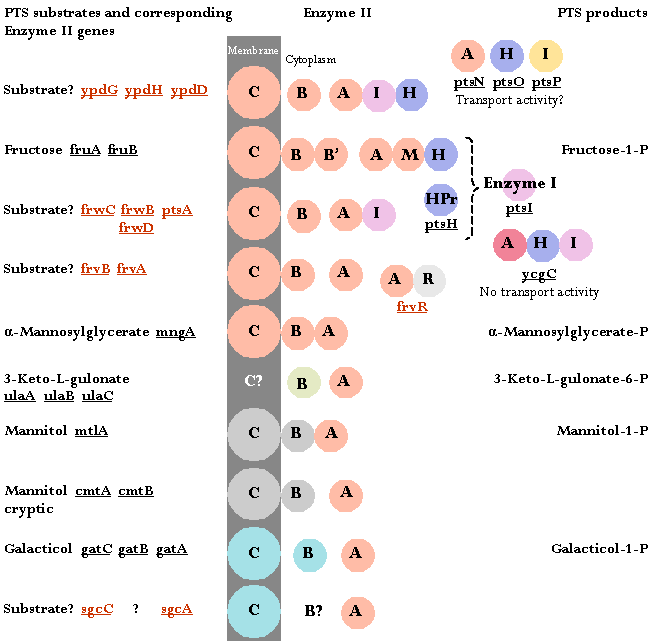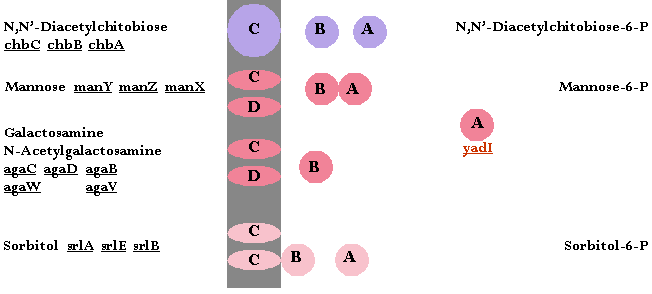Color-coded PTS of Escherichia coli K12
Copyright © 2004 Mednansky Institute, Inc.


Representation of proteins does not account for molecular weight or oligomeric structure. As of 2004, there is no experimental data available for genes indicated in red. Colors of proteins are coordinated with the protein classification found in the COG database. For example, all 'C domains' of the fructose permeases (including putative ones) belong to COG1299, namely 'Phosphotransferase system, fructose-specific IIC component'. The 'A domain' of the phosphoprotein encoded by ycgC (not represented in the color-coded PTS) is classified as uncharacterized in the COG database. However by using 3-D template matching, Gutknecht R, 2001 showed the 'A domain' to be affiliated to the mannose-specific IIA component.
CmtB (encoded by cmtB) and the IIA domain of Enzyme IICBAMtl (encoded by mtlA) are structurally similar overall, however local structural differences exist in the active site (Yu C, 2007).
The frvR gene encodes a two-domain protein, the amino-terminal domain (indicated as R) belongs to COG3711 typified by BglG. BglG is a cytoplasmic response regulator whose function, as a transcriptional antiterminator, is regulated by BglF-mediated reversible phosphorylation (Lopian L, 2003; Raveh H, 2009; Rothe FM, 2012). Incidentally, translocation of PTS sugars by BglF has been studied in detail by Yagur-Kroll S, 2009. The domain composition of FrvR seems to be reminiscent of the one described for the regulator LicR from Bacillus subtilis (Tobisch S, 1999).
The so-called nitrogen PTS (PTSNtr, ptsN, ptsO, ptsP), lacking the B and C domains of the PTS, has not been involved in transport. Enzyme IIA encoded by ptsN affects amino acids biosynthesis (Lee CR, 2005). It possibly interacts with TrkA which participates in potassium transport (Lee CR, 2007), and most likely with potassium sensor kinase KdpD (Lüttmann D, 2009). It is found readily phosphorylated in vivo (Zimmer B, 2008). Regulatory roles for ptsN-, ptsO- and ptsP-encoded proteins were described, and comparatively analyzed (Pflüger-Grau K, 2010). In 2011, the role of ptsN-encoded EIIANtr in regulating organic nitrogen source utilization, as previously proposed, was discarded (Reaves ML, 2011). E. coli EIIANtr may alters the response to phosphate starvation by binding histidine kinase PhoR (Lüttmann D, 2012), and NPr (encoded by ptsO) may play a role in stress response depending on the state of phosphorylation (Lee J, 2015).
Another cryptic operon for utilization of β-glucosides was discovered in septicemic and uropathogenic E. coli (Neelakanta G, 2009).
Growth efficiency on N-acetylglucosamine as sole carbon source is related to various factors (Álvarez-Añorve LI, 2005).
E. coli K12 is unable to grow on galactosamine and N-acetylgalactosamine due to a deletion within the aga genes causing loss of the corresponding IIA domain (Brinkkötter A, 2000). However the ability to grow on galactosamine and N-acetylgalactosamine differs among enteric bacteria. Strains of enterohemorrhagic Escherichia coli O157:H7 isolated from produce-associated outbreaks have lost the capability to grow on N-acetylgalactosamine (Mukherjee A, 2008; Hu Z, 2013).
Chromosomal location of the gat operon is not conserved among Enterobacteriaceae (Shakeri-Garakani A, 2004).
The trehalose PTS can be used for transport of sucrose in amount sufficient to allow induction of the sucrose catabolism operon (Steen JA, 2014).
Complete genome sequence of Escherichia coli strain BW25113 revealed a deletion in gatC and a substitution in nagE, as compared to E. coli strain MG1655 (Grenier F, 2014).
Sorbitol was erroneously described as a non-PTS sugar (Aidelberg G, 2014, Comment)